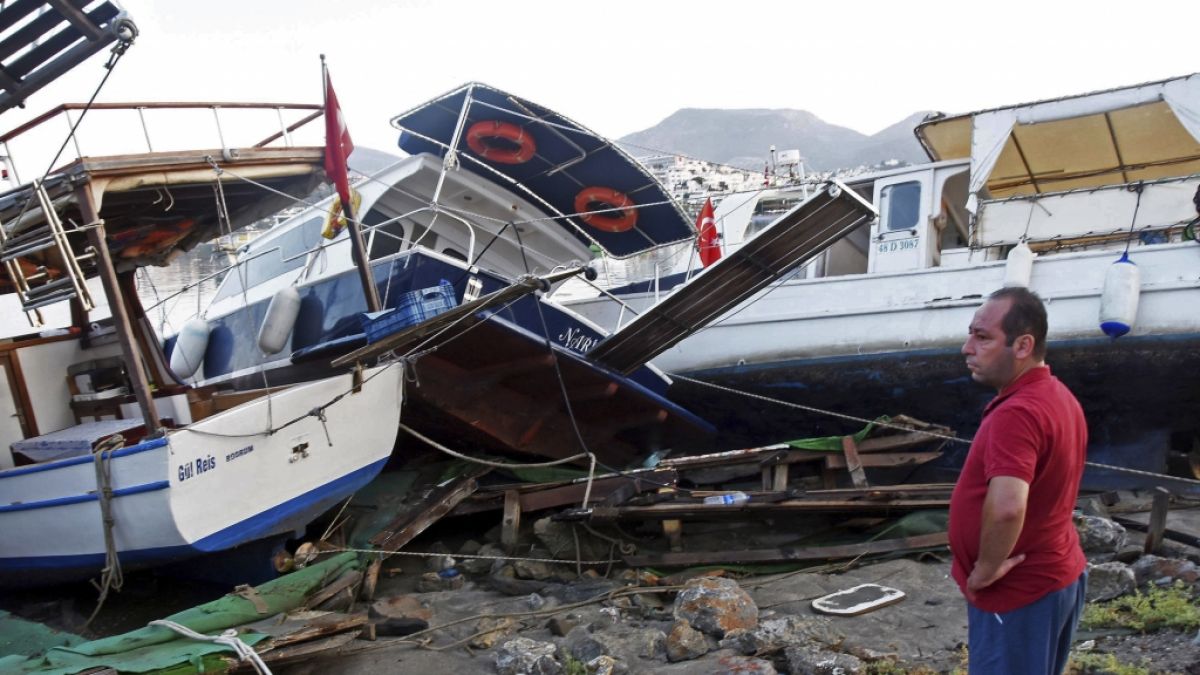A magnitude 6 earthquake struck 238 km southwest of Port McNeil, Canada. Get all the details about the earthquake here.
Symbolic image: An earthquake shakes the coastal city Image: Picture Alliance / Yasar Anter/AP/dpa | Yasser Ander
On Thursday, April 13, 2023, at 5:54 p.m., an undersea earthquake measuring 6 on the Richter scale occurred. But what does this classification really mean and what values can be used to more accurately classify an earthquake?
What do we currently know about earthquakes?
The earthquake spread across the sea. 238 km southwest of Port McNeil, Canada happened However, no cities near the epicenter are known to have been directly affected by the quake. The earthquake was classified as level 6 on the Richter scale. However, apart from this size, there are other details that can be informative when evaluating a natural phenomenon. For example, the depth at which the earthquake begins to rupture is important for assessing the intensity of an earthquake. The event is currently thought to be 7 km deep, 238 km southwest of Port McNeil, Canada. This value also affects the extreme values of sea tremors, which vary from place to place due to various factors, but can still be recorded as a maximum. A distinction is made between experienced and rated severity. While the former is captured by concrete reported values, the latter is intensity assessed by measuring instruments. Values are also based on the Richter scale. In the current event, a maximum experienced intensity of 2.7 and a maximum estimated intensity of 3.603 were reported.
How accurate is this information about an earthquake near Canada?
Seismic stations used to determine the location of an earthquake can calculate accurate information about the earthquake. Because the number for this earthquake is relatively high, current knowledge of earthquakes can initially be classified more accurately compared to other measurements. The accuracy estimate is supplemented by the distance between neighboring stations. In general, the smaller it is, the more reliable the calculated horizontal position of the earthquake. In the present case, this distance is averaged, which is why the determination of the location of the earthquake is estimated to be reliable on average.
Quick check: the most important details at a glance
| Earthquake: Canada | |
|---|---|
| Position: | 238 km southwest of Port McNeil, Canada |
| Integrations: | Latitude = 49.207° and Longitude = -129.62° |
| Places within 100 km radius: | Not specified |
| Size: | 6 |
| Accuracy: | Very accurate |
| Credibility: | Average reliable |
| Depth: | 7 kilometers |
| Experienced Intensity: | 2.7 |
| Rated Severity: | 3,603 |
| Notification Time: | 04/13/2023 – 17:54 |
Richter Scale for Earthquakes: How to Assess Hazards?
Developed and introduced by American seismologist Charles Francis Richter in the 1930s, the Richter scale uses a scale derived from the Latin word for “magnitude” to help make statements about the strength of earthquakes and tremors. (quantity) is formed. To determine the magnitude of an earthquake, vibration is measured using a seismometer. To do this, it is necessary to know the distance between the measuring station and the source of the earthquake. The largest ground motion, the maximum deflection (amplitude), is read from the seismometer’s graphic representation – the seismogram. This amplitude combined with distance gives magnitude. Richter introduced a logarithmic scale to make it easier to read deviations on a seismogram. A magnitude 7 earthquake is 10 times larger than a magnitude 6, 100 times larger than a magnitude 5, and 1000 times larger than a magnitude 4.
Classification of earthquakes on the Richter scale
| Richter scales | Classification of earthquake strength | Earthquake damage | Global frequency of events |
|---|---|---|---|
| < 2.0 | Micro | Micro earthquakes, not felt | 8000 x per day (from dose 1.0) |
| 2.0 to 3.0 | Very light | Usually not noticed, but measured | 1500x per day |
| 3.0 to 4.0 | Very easily | Often observed, very rarely damage | 135 times a day |
| 4.0 to 5.0 | the light | Objects in the room move visually, vibration sounds, mostly no damage | 35 times a day |
| 5.0 to 6.0 | Medium strength | Severe damage to vulnerable buildings, no light damage to strong buildings | 4.5 times a day, 1600 times a year |
| 6.0 to 7.0 | Strong | Destruction within 70 km radius | 130x per year |
| 7.0 to 8.0 | Big | Devastation in large areas | 13 times a year |
| 8.0 to 9.0 | so big | Devastation over hundreds of kilometers | 0.9x per year |
| 9.0 to 10.0 | Very large | Destruction of thousands of kilometers | 4 times in 122 years (1952/60/64, 2011) |
| More than 10 | Global catastrophe | Never recorded, believed to be magnitude 11 quake 66 million years ago, triggered by asteroid impact in Yucatan | 1 x in 66 million years |
Before the introduction of the Richter scale, other scales were used to measure earthquakes, for which the Richter values did not change properly, and that is why the previously measured earthquakes could not be described. However, there have been at least five documented earthquakes of magnitude 9 or greater since measurements began using this scale. These occurred in Russia (1952), Chile (1960), Alaska (1964), Indonesia (2004) and Japan (2011). An earthquake measuring 7.8 on the Richter scale struck Turkey and Syria on February 6, 2023. The earthquake caused a huge number of casualties, which cannot be ascertained with certainty at present.
+++ Editor’s Note: This text is automatically generated based on current data from the USGS (US Geological Survey). The USGS sent the last update on the event on April 13, 2023 – 9:55 p.m. Get more information about the event Here at the official USGS site. We welcome feedback and comments at [email protected]. +++
Follow along News.de Already at Facebook, Twitter, Pinterest And Network light? Here you will find the latest news, latest videos and direct lines to editors.
roj/news.de
Get notifications

“Communicator. Entrepreneur. Introvert. Passionate problem solver. Organizer. Social media ninja.”





More Stories
Great Britain wants to immediately deport asylum seekers without valid documents to Rwanda in the future.
Great Britain wants to increase defense spending to 2.5 percent of GDP
SWR and School of the Future / Journalist Frank Seibert looks for new school models in Dresden, Winnipeg (Canada) and Essen